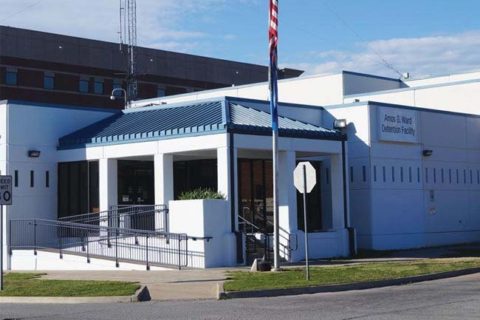When you visit an inmate, it may not be as free as visiting someone at their home or at any other places. There are some restrictions that you have to obey. So, how about kissing and hugging? Is it permitted during visitation? Let’s read the explanation about it here.
Physical Contact with Inmates During Visitation
According to the BOP website, usually, physical contact like hugs, handshakes, and kisses (in good taste) are permitted at the beginning and end of a visit. However, staff may limit contact for security reasons where it is done to prevent people from trying to introduce contraband and to keep the visiting area orderly. On that site, it is also explained that the Federal Bureau of Prisons does not allow conjugal visits.

When you visit an inmate, it is important for you that your visit must be quiet, orderly, and dignified. It is because there are also a lot of people who are usually visiting. If you or the inmate is not acting appropriately, the visiting room officer can ask you to leave.
How about the visiting duration? On the BOP site, it is explained that by law, an inmate can get at least four hours of visiting time per month, but the prison is able to provide more than that. Even though the prison can provide more time for visiting, but the warden is able to restrict the length of visits or the number of people who are able to visit at once where it is done to avoid overcrowding in the visiting room.
On the Prison Insight site, it is explained that when an inmate first comes into the visiting room when he or she is visited by a visitor, the visitor is permitted to do a brief hug and kiss where this rule also applies to the end of the visit. However, during a visit, the only physical contact which is permitted is holding hands. It is understandable when you think that the rules are very strict. It is because as explained earlier that it is done to prevent people from introducing contraband. There may be a possibility that visitors bring in drugs inside their mouth and they may pass the drugs along to the inmate with a long kiss or there may be visitors who sneak drugs, tobacco, cell phones and the other prohibited items into the visiting room and pass the items during a hug, put them in the visitor bathroom, or in the vending machines where the inmates can find the items later. Even though this idea sounds crazy, but people do these extreme things to be able to bring in contraband. So, that’s why the rules of visiting inmates are strict.
There is also a situation where an inmate is separated from the general population or in a certain custody level. In this situation, usually they are only permitted non-contact visits where an inmate and the visitors are separated by a glass partition and they talk through the partition or use a phone.
Dress Code for Visiting Inmates
When you are visiting an inmate, it does not mean that you can wear anything that you want. As explained earlier, there are rules that you need to obey including about dressing. As explained on the BOP site, when you are visiting an inmate, you have to wear clothing which is appropriate for a large gathering of men, women and your children. If you wear clothing which is not appropriate such as provocative or revealing clothes, you may be denied to visit the inmate.
According to the BOP site, in the list below, you are able to read the clothing items which are generally not permitted. However, you have to consult the visiting policy for the specific facility as to what attire and items that are allowed in the visiting room.
-
- revealing shorts
- halter tops
- bathing suits
- see-through garments of any type
- crop tops
- low-cut blouses or dresses
- leotards
- spandex
- miniskirts
- backless tops
- hats or caps
- sleeveless garments
- skirts two inches or more above the knee
- dresses or skirts with a high-cut split in the back, front, or side
- clothing that looks like inmate clothing (khaki or green military-type clothing)
Scheduling the Visiting Time with Inmates
If you want to visit an inmate, you have to make sure that it is the appropriate time because correctional facilities are not always open for 24 hours for visiting. It is also important for you to know the rules and also prepare anything before you go.
According to the BOP site, all institutions have visiting hours on Saturdays, Sundays, and holidays and most have them at other times during the week. The most popular time to visit is on weekends. So, prisons may decide to limit visits to Saturday or Sunday and the day will vary for each inmate. There are also other factors that can affect the days and times you can visit including the prison type, the location of the prison, availability of visiting space and inmate visiting needs. It is important for the inmate to inform you about the visiting schedule for that prison. However, if the inmate does not inform you or you may have any questions related to visiting inmates, you are able to contact the facility where your loved one is incarcerated.
How about getting to the facility where the inmate is incarcerated? On the BOP site, it is explained that there is no Government payment or reimbursement for transportation. So, when you want to visit an inmate, you have to arrange transportation to and from the facility accordingly and if you have any questions, you are able to contact the prison facility. When you contact the prison facility, there will be staff who will help with directions, including how to get there by public transportation when available.
People Who Are Permitted to Visit Inmates
When someone is incarcerated, it does not mean that he or she can be visited by anyone. According to the BOP site, people who can visit the inmate are only the people who are on the inmate’s visiting list. If you are on the inmate’s visiting list and you have been cleared by the BOP, you can visit the inmate.
According to the BOP site, here are people who can be added by inmates to their visiting list.
-
- Immediate family: father, mother, step parents, foster parents, sisters, brothers, spouse and children.
- Relatives: grandparents, aunts, uncles, in-laws, and cousins.
- Other types of approved visitors: foreign officials, no more than 10 friends/ associates, members of religious groups including clergy, members of civic groups, employers, sponsors, parole advisors, and attorneys.

A bookworm and researcher especially related to law and citizenship education. I spend time every day in front of the internet and the campus library.




